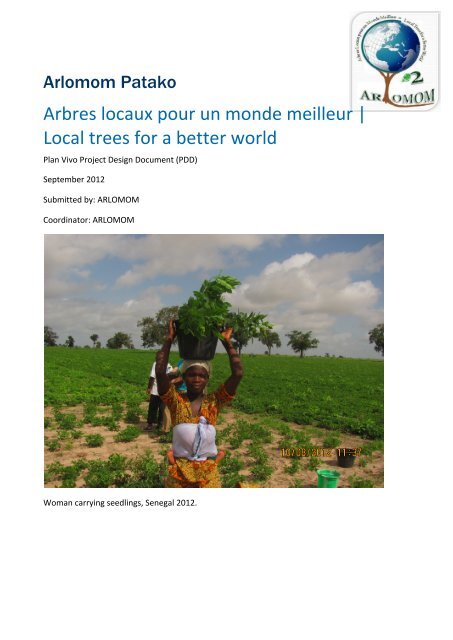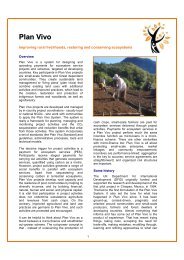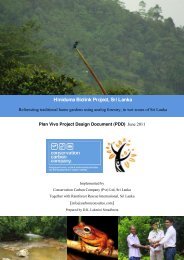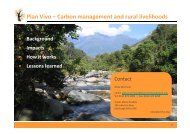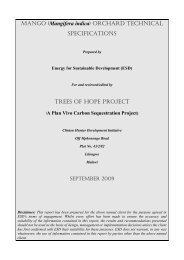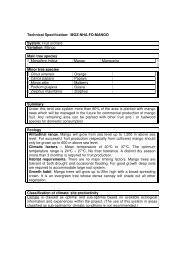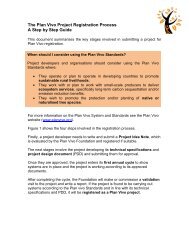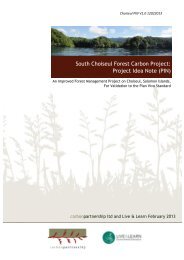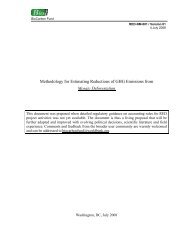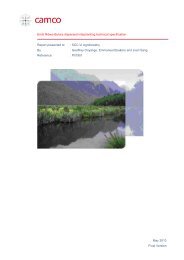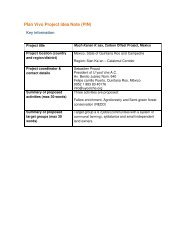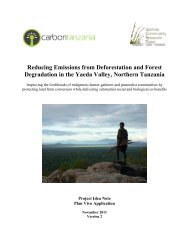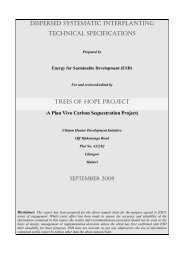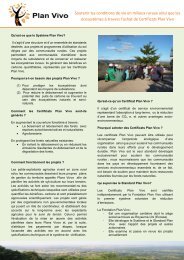Arbres locaux pour un monde meilleur | Local trees for a better world
Arbres locaux pour un monde meilleur | Local trees for a better world
Arbres locaux pour un monde meilleur | Local trees for a better world
You also want an ePaper? Increase the reach of your titles
YUMPU automatically turns print PDFs into web optimized ePapers that Google loves.
Arlomom Patako<br />
<strong>Arbres</strong> <strong>locaux</strong> <strong>pour</strong> <strong>un</strong> <strong>monde</strong> <strong>meilleur</strong> |<br />
<strong>Local</strong> <strong>trees</strong> <strong>for</strong> a <strong>better</strong> <strong>world</strong><br />
Plan Vivo Project Design Document (PDD)<br />
September 2012<br />
Submitted by: ARLOMOM<br />
Coordinator: ARLOMOM<br />
Woman carrying seedlings, Senegal 2012.
Contents<br />
1 TITLE OF PROJECT: ARLOMOM PATAKO .................................................................... 1<br />
2 EXECUTIVE SUMMARY ................................................................................................. 1<br />
3 AIMS AND OBJECTIVES ................................................................................................ 2<br />
4 SITE INFORMATION, ACTIVITIES AND CARBON BENEFIT ....................................... 3<br />
4.1. PROJECT LOCATION, LAND TYPE AND BOUNDARIES ............................................................. 3<br />
PROJECT LOCATION ..................................................................................................................... 3<br />
4.2 DESCRIPTION OF THE PROJECT AREA .................................................................................. 3<br />
4.3. PROJECT ACTIVITIES ........................................................................................................ 5<br />
AFFORESTATION/REFORESTATION - MIXED NATIVE SPECIES PLANTATION ..................................................... 5<br />
AGROFORESTRY - INTERCROPPING AND BOUNDARY PLANTING ................................................................. 5<br />
ASSISTED NATURAL REGENERATION ................................................................................................. 6<br />
NATIVE TREE SPECIES .............................................................................................................. 6<br />
4.4. DESCRIPTION OF THE PLAN VIVO TECHNICAL SPECIFICATIONS ............................................ 6<br />
4.5. DURATION OF PROJECT ACTIVITIES AND CREDITING PERIOD ................................................. 7<br />
4.6. CARBON BENEFITS OF PROJECT ACTIVITIES ........................................................................ 7<br />
4.7. PROCESS AND REQUIREMENTS FOR REGISTERING PLAN VIVOS ............................................. 7<br />
5 PROJECT GOVERNANCE AND FINANCIAL STRUCTURE ............................................ 8<br />
5.1. PROJECT ORGANISATIONAL STRUCTURE ............................................................................. 8<br />
5.2. RELATIONSHIP TO NATIONAL ORGANISATIONS .................................................................... 9<br />
5.3. PROJECT FINANCIAL STRUCTURE (SHARING OF BENEFITS) ................................................. 10<br />
6 COMMUNITY AND LIVELIHOOD INFORMATION ...................................................... 11<br />
6.1. TARGET COMMUNITIES ................................................................................................... 11<br />
6.2. OWNERSHIP OF CARBON BENEFITS ................................................................................. 13<br />
6.3. SOCIO-ECONOMIC CONTEXT AND ANTICIPATED IMPACTS .................................................... 14<br />
6.4. COMMUNITY-LED DESIGN AND LIVELIHOOD BENEFITS ....................................................... 14<br />
6.5. CAPACITY BUILDING AND TRAINING ................................................................................. 15<br />
6.6. MONITORING LIVELIHOOD AND SOCIO-ECONOMIC IMPACTS ................................................ 15<br />
7 ECOSYSTEM IMPACTS AND MONITORING .............................................................. 16<br />
8 ADDITIONALITY OF PROJECT AND PROJECT ACTIVITIES ...................................... 17<br />
9 MONITORING, TECHNICAL SUPPORT AND PAYMENT PLAN ................................. 18<br />
MONITORING OF PERFORMANCE INDICATORS ........................................................................... 18<br />
PAYMENT PLAN ..................................................................................................................... 18<br />
TECHNICAL SUPPORT ............................................................................................................. 19
10 COMPLIANCE WITH THE LAW ................................................................................. 19<br />
11 CERTIFICATION OR EVALUATION TO OTHER STANDARDS .................................. 20<br />
12 REFERENCES ............................................................................................................ 20<br />
13 APPENDICIES ............................................................................................................ 22<br />
APPENDIX A: LIST OF RESPONSIBLE STAFF AND CONTACT INFORMATION .................................... 22<br />
APPENDIX B: FUNDING .......................................................................................................... 22<br />
APPENDIX C: TECHNICAL SPECIFICATIONS ............................................................................... 22<br />
APPENDIX D: COMMUNITY PES CONTRACTS ............................................................................ 23<br />
APPENDIX E: DATABASE TEMPLATE ......................................................................................... 23<br />
APPENDIX F: PERMITS AND LEGAL DOCUMENTATION ................................................................ 23<br />
APPENDIX G: EVIDENCE OF COMMUNITY PARTICIPATION E.G. MEETING MINUTES ........................ 23<br />
APPENDIX H: SUPPORT OF NATIONAL ORGANISATIONS .............................................................. 23<br />
APPENDIX I: ANNUAL REPORTS ............................................................................................... 23<br />
APPENDIX J: VERIFICATION REPORTS ...................................................................................... 24<br />
Acronyms<br />
ACRONYM Name<br />
ISE Institute of Sciences and the Environment<br />
KSD Rural comm<strong>un</strong>ity of Keur Saloum Diané<br />
KSG Rural comm<strong>un</strong>ity of Keur Samba Gueye<br />
NTFPs Non-‐Timber Forest Products<br />
PES Payments <strong>for</strong> Ecosystem Services<br />
UNDESERT Understanding and combating desertification to mitigate its impact on ecosystem services<br />
URENE Natural Ecosystems and the Environment Unit
1<br />
Comm<strong>un</strong>ity Payments <strong>for</strong> Ecosystem Services in Patako | Plan Vivo PDD 2012<br />
1 Title of project: Arlomom Patako<br />
2 Executive summary<br />
This Project Design Document describes the Arlomom Patako Plan Vivo project. Arlomom Patako<br />
was initiated in 2010 as an innovative component of the UNDESERT 1 program financed by the<br />
European Commission (EU-‐FP7 243906). The project aims to develop sustainable land<br />
management practices that combine existing and improved agricultural land uses with<br />
re<strong>for</strong>estation and agro<strong>for</strong>estry activities with native tree species.<br />
Arlomom, a registered association in Senegal, is coordinating the project. Members of Arlomom<br />
are drawn from the Institute of Sciences and the Environment (ISE) and Natural Ecosystems and<br />
the Environment Unit (URENE), both of which are connected to the Cheikh Anta Diop University in<br />
Dakar (UCAD). The Arlomom Patako project is being developed <strong>un</strong>der the auspices of the EU<br />
UNDESERT program.<br />
This project utilises the Plan Vivo System and Standard as a framework to link the ecosystem<br />
services, generated by rural comm<strong>un</strong>ities, to payment mechanisms and markets. Bioclimate<br />
Research & Development Ltd. (hereafter Bioclimate) provides; knowledge transfer, guides project<br />
development and assists with project planning, comm<strong>un</strong>ity engagement, technical development<br />
and Plan Vivo qualification.<br />
The Arlomom project is located in the Patako Forest landscape, which is situated in the Saloum<br />
region of West-‐Central Senegal, north of Gambia. The participating comm<strong>un</strong>ities in the project<br />
activities are from four villages: Médina Ngayène, Keur Andalla Willane, Ndiaye Co<strong>un</strong>da (Nimbato)<br />
and Diankou Bodian. These comm<strong>un</strong>ities lie within 2 km of Patako Forest.<br />
Keur Andalla Willane, Ndiaye Co<strong>un</strong>da (Nimbato) and Diankou Bodian lie within the Keur Saloum<br />
Diané (KSD) rural co<strong>un</strong>cil area. Médina Ngayène is in the Keur Samba Guéye (KSG) rural co<strong>un</strong>cil<br />
area.<br />
The goal of the project is to restore de<strong>for</strong>ested and highly degraded land in the Patako landscape<br />
1 UNDESERT (EU FP7 243906), "Understanding and combating desertification to mitigate its<br />
impact on ecosystem services" is f<strong>un</strong>ded by the European Commission, Directorate General <strong>for</strong><br />
Research and Innovation, Environment Programme.
2<br />
Comm<strong>un</strong>ity Payments <strong>for</strong> Ecosystem Services in Patako | Plan Vivo PDD 2012<br />
by empowering local subsistence farmers and by generating finance from the sale of carbon<br />
credits. The methods <strong>for</strong> quantifying carbon stocks and carbon benefits and generating Plan Vivo<br />
Certificates were developed using an af<strong>for</strong>estation and agro<strong>for</strong>estry Plan Vivo technical<br />
specification developed by Arlomom. Project activities <strong>un</strong>dertaken in the project area include:<br />
af<strong>for</strong>estation/re<strong>for</strong>estation, agro<strong>for</strong>estry, and assisted natural regeneration.<br />
This project has a crediting period of thirty years and a payment period of ten years. F<strong>un</strong>ding has<br />
been secured <strong>for</strong> the first year of activities and the first tranche of PES incentives to participants.<br />
Certificates will be issued ex-‐ante, after annual reporting to the Plan Vivo Fo<strong>un</strong>dation. After each<br />
successful monitoring period, payments will be made to participants. The certifiable carbon<br />
benefits from each activity are as follows: intercropping 28 tCO2/ha, bo<strong>un</strong>dary planting 32<br />
tCO2/ha, plantation 296 tCO2/ha, assisted natural regeneration 296 tCO2/ha.<br />
3 Aims and objectives<br />
The overall aim of the project is to combat desertification and land degradation by improving the<br />
livelihoods of rural comm<strong>un</strong>ities in West Africa and their capacity to generate ecosystem services.<br />
The core objective of the Arlomom Patako project is to restore de<strong>for</strong>ested and highly degraded<br />
land in the Patako landscape by empowering subsistence farmers to adopt sustainable<br />
agro<strong>for</strong>estry and <strong>for</strong>estry practices using native tree species.<br />
The following specific objectives will contribute to the overall aims and the core objective:<br />
1. Reduce resource and income poverty and increase social resilience in the face of climate<br />
change through participation in organised resource conservation activities that support<br />
livelihoods<br />
2. Improve ecological sustainability and food security through more diverse and drought, pest<br />
and disease-‐resilient agro-‐ecosystems<br />
3. Improve economic sustainability and reduce exposure to fluctuations in the prices of crops<br />
and fruits through greater product diversity<br />
Tree planting and management will help to reduce poverty by; strengthening the local economy,<br />
reducing land degradation and promoting biodiversity. Payments <strong>for</strong> Ecosystem Services (PES) will<br />
provide local farmers with an additional revenue stream that will supplement income from<br />
af<strong>for</strong>estation and agro<strong>for</strong>estry activities as well as traditional agriculture (e.g. gro<strong>un</strong>dnuts, millet,<br />
and sorghum).
3<br />
Comm<strong>un</strong>ity Payments <strong>for</strong> Ecosystem Services in Patako | Plan Vivo PDD 2012<br />
4 Site in<strong>for</strong>mation, activities and carbon<br />
benefit<br />
4.1. Project location, land type and bo<strong>un</strong>daries<br />
Project location<br />
The Patako Forest landscape is situated in the Saloum region of West-‐Central Senegal, north of<br />
Gambia. Figure 1 shows the location of Patako Forest in Senegal and the initial project sites.<br />
Figure 1: Location of the Patako Forest with locations of initial project sites<br />
4.2 Description of the project area<br />
Keur Andalla<br />
Willane<br />
Médina Ngayène<br />
Ndiaye Co<strong>un</strong>da (Niombato)<br />
Diankou<br />
Bodian<br />
The area is located in the sub-‐humid and seasonal tropical climate zone. Annual precipitation is<br />
approximately 770 mm and falls mainly in a four-‐month period from July to October. As in other<br />
parts of the Sahel, the area suffered from an extended drought when precipitation declined by<br />
20% from 1967 to 1997 (Woomer et al., 2004; Tappan et al., 2004). Recent precipitation data<br />
shows an increasing trend in rainfall.<br />
Soils consist mainly of Lixisols, which are potentially fertile (CR – KSD 2002) but are becoming<br />
increasingly sandy and deteriorating due to intensive farming.<br />
The landscape aro<strong>un</strong>d the Patako Forest was once Sudanian savanna, but has become open<br />
savannah mixed with agroecosystems (Van Noordwijk and Ong, 1999). Trees in this mixed<br />
landscape are sparsely distributed and declining in number. Much of the land is used <strong>for</strong> crops and<br />
livestock as people are reliant on farming <strong>for</strong> food and income. The main food-‐crop is pearl millet<br />
(Pennisetum glaucum), and the main commercial crop is gro<strong>un</strong>dnuts (Arachis hypogea). All crops<br />
are rain fed and cultivated using a mixture of animal drawn implements and hand tools. In the dry<br />
season, vegetables are grown in riverine areas, especially onions (Allium cepa). Cashew
4<br />
Comm<strong>un</strong>ity Payments <strong>for</strong> Ecosystem Services in Patako | Plan Vivo PDD 2012<br />
(Anacardium occidentale) and mango (Mangifera indica) are the most common fruit <strong>trees</strong>.<br />
The Patako Forest is an island of biodiversity and an important carbon sink (Montagnini and Nair,<br />
2004). Figure 2 shows <strong>for</strong>est cover within the core of the <strong>for</strong>est. In contrast, tree cover in the<br />
cultivated land areas aro<strong>un</strong>d Patako Forest is very low (aro<strong>un</strong>d 1%, Christensen, 2010). Trees are<br />
sparsely distributed as most have been cleared. Naturally occurring <strong>trees</strong> have been cleared to <strong>for</strong><br />
crops, firewood and timber and are still declining by 3% per annum on agricultural land (<br />
Figure 2: Patako Forest<br />
).<br />
Figure 2: Patako Forest<br />
In Figure 3, the photo on the left shows land denudation caused by <strong>un</strong>sustainable farming<br />
practices. This gives rise to soil erosion and loss of soil fertility. The photo on the right shows<br />
degradation of relatively dense vegetation stands in Patako Forest.
5<br />
Comm<strong>un</strong>ity Payments <strong>for</strong> Ecosystem Services in Patako | Plan Vivo PDD 2012<br />
Figure 3. Landscape aro<strong>un</strong>d Patako Forest<br />
Soils and plant vegetation in the Patako landscape are being degraded mainly as a result of<br />
population pressure (Chikanda, 2009), a lack of capacity to improve agricultural productivity using<br />
sustainable farming methods, and a lack of livelihood alternatives beyond activities that involve<br />
overexploitation of natural resources.<br />
Patako Forest is exposed to intensive fires and wood is harvested illegally <strong>for</strong> fuel wood. Simply<br />
en<strong>for</strong>cing existing <strong>for</strong>est protection measures in the central <strong>for</strong>est more strictly will fail to achieve<br />
the desired outcome. It is imperative to work closely with comm<strong>un</strong>ities to develop a more<br />
comprehensive and integrated management system.<br />
4.3. Project activities<br />
Project activities <strong>un</strong>dertaken in the project area include: af<strong>for</strong>estation/re<strong>for</strong>estation, agro<strong>for</strong>estry,<br />
and assisted natural regeneration.<br />
Af<strong>for</strong>estation/re<strong>for</strong>estation - mixed native species plantation<br />
Participants will create small mixed native species plantations. These plantations will produce a<br />
variety of goods and relieve some of the pressure on mature standing <strong>trees</strong> caused by demand <strong>for</strong><br />
firewood and construction timber, as some of the fruit and nut <strong>trees</strong> can be pr<strong>un</strong>ed <strong>for</strong> firewood.<br />
Agro<strong>for</strong>estry - intercropping and bo<strong>un</strong>dary planting<br />
Participants will interplant native <strong>trees</strong> and crops on agricultural land. Nitrogen fixing and soil<br />
enhancing species will improve soil quality and crop yields. In addition to improving biodiversity,<br />
ecosystem resilience and f<strong>un</strong>ctions (e.g. hydrological flows, improved soil structure and retention,<br />
nutrient recycling), agro<strong>for</strong>estry activities will improve the productivity, diversity and sustainability<br />
of cultivation activities practised by households.
6<br />
Comm<strong>un</strong>ity Payments <strong>for</strong> Ecosystem Services in Patako | Plan Vivo PDD 2012<br />
Assisted natural regeneration<br />
Participants will assist regenerating seedlings to become established and regeneration areas will<br />
be fenced with living fences (“haie vive” in French) to prevent seedlings being damaged by<br />
livestock grazing. Some seedlings will also be planted to enrich and assist natural regeneration<br />
processes and increase the establishment rate of economically important species.<br />
Once tree planting and management activities are <strong>un</strong>derway, it will be possible to engage<br />
comm<strong>un</strong>ities in activities that directly protect and reduce degradation of the central Patako<br />
Forest. A partnership and joint management plan in which responsibilities are shared between<br />
comm<strong>un</strong>ities and authorities from the Forest Service will be required <strong>for</strong> this project activity.<br />
Native tree species<br />
Planting native species will help to maintain and conserve biodiversity and will provide other<br />
benefits, including:<br />
• Fruits, leaves, bark and roots <strong>for</strong> food and medicine <strong>for</strong> local use<br />
• Products <strong>for</strong> sale where there is a national market in the food, cosmetics and<br />
pharmaceutical industries<br />
• Improved soil fertility through nitrogen-‐fixing<br />
• Erosion control through rooting systems that help bind soil<br />
• Fodder <strong>for</strong> livestock<br />
• Fuel wood that will be harvested sustainably<br />
4.4. Description of the Plan Vivo Technical Specifications<br />
The af<strong>for</strong>estation and agro<strong>for</strong>estry Plan Vivo technical specification is applicable to degraded land<br />
aro<strong>un</strong>d Patako <strong>for</strong>est. Agro<strong>for</strong>estry, which includes intercropping and bo<strong>un</strong>dary planting, takes<br />
place on cropland. Af<strong>for</strong>estation, which is the establishment of small plantations, and assisted<br />
natural regeneration take place on degraded, neglected, or previous agricultural land (Table 1).<br />
Table 1: Technical specification<br />
Title Type of<br />
activity<br />
Agro<strong>for</strong>estry -‐<br />
Intercropping<br />
Agro<strong>for</strong>estry -‐<br />
Bo<strong>un</strong>dary<br />
planting<br />
Tree<br />
planting<br />
Tree<br />
planting<br />
Objectives Brief description<br />
Biodiversity conservation<br />
and increased soil fertility and<br />
crop yields<br />
Biodiversity conservation and<br />
land demarcation, firewood, fruit,<br />
shade, improved soil fertility,<br />
Nitrogen fixing tree species planted at<br />
a low density throughout an area of<br />
cultivated land. Crops continue to be<br />
grown in the area and the nitrogen<br />
fixing <strong>trees</strong> improve soil productivity<br />
Trees planted along the perimeter of<br />
individual farms or comm<strong>un</strong>al lands
7<br />
Comm<strong>un</strong>ity Payments <strong>for</strong> Ecosystem Services in Patako | Plan Vivo PDD 2012<br />
Af<strong>for</strong>estation -‐<br />
Plantation<br />
Assisted<br />
Natural<br />
Regeneration<br />
Tree<br />
planting<br />
Natural<br />
regeneratio<br />
n through<br />
protection<br />
and<br />
enrichment<br />
planting<br />
protection of crops against wind<br />
Biodiversity conservation<br />
and reduction of pressure on the<br />
<strong>for</strong>est<br />
Natural fruits, berries, firewood<br />
and fodder<br />
Biodiversity conservation<br />
and reduction of pressure on the<br />
<strong>for</strong>est<br />
Natural fruits, berries, firewood<br />
and fodder<br />
4.5. Duration of project activities and crediting period<br />
Forest plantations with a variety of<br />
native species<br />
Assisted natural regeneration to<br />
increase the stocking of valuable<br />
species. It involves enrichment<br />
planting and managing natural<br />
regeneration by fencing off areas to<br />
prevent grazing<br />
This project has a crediting period of 30 years (2012-‐2042). The payment period is 10 years.<br />
4.6. Carbon benefits of project activities<br />
For each activity, the certifiable carbon benefit has been estimated using a CO2FIX model. The<br />
certifiable carbon benefit is the carbon sequestration of the activity over 30 years. The<br />
sequestration potential is treated over and above the baseline figure of 8tCO2 per ha, and the risk<br />
buffer of 10% (Table 2) is subtracted. Please see the af<strong>for</strong>estation and agro<strong>for</strong>estry technical<br />
specification <strong>for</strong> details.<br />
Table 2: Summary of baseline and project carbon uptake per hectare over crediting period (figures<br />
have been ro<strong>un</strong>ded down)<br />
Systems Carbon<br />
sequestration<br />
(t C/ha)<br />
Carbon dioxide<br />
sequestration<br />
equivalent<br />
(t CO2e/ha)<br />
Baseline<br />
(t CO2/ha)<br />
Risk buffer<br />
(10 %)<br />
Intercropping 11 40 8 4 36<br />
Bo<strong>un</strong>dary<br />
planting<br />
12 44 8 4 40<br />
Plantation 92 337 8 34 303<br />
Assisted<br />
Natural<br />
Regeneration<br />
92 337 8 34 303<br />
4.7. Process and requirements <strong>for</strong> registering plan vivos<br />
Project scenario<br />
(t CO2e/ha)<br />
Plan vivos are land management plans which are designed to generate ecosystem services.<br />
Arlomom has worked with participants to ensure that the participant plan vivos meet the<br />
participant livelihood needs and that the activities outlined in the plan vivo do not endanger food
8<br />
Comm<strong>un</strong>ity Payments <strong>for</strong> Ecosystem Services in Patako | Plan Vivo PDD 2012<br />
security or displace other land-‐uses. The plan vivos are available to the Plan Vivo Fo<strong>un</strong>dation and<br />
to external validation or certification agents.<br />
Arlomom has contracts with individual participants and with women’s groups (See the sample<br />
contract in Appendix D). Each women’s group has both a PES contract with Arlomom and a written<br />
benefit sharing agreement that describes how the women’s group will share benefits fairly<br />
amongst themselves through disbursement of payments, investments, or development of<br />
livelihood activities.<br />
Be<strong>for</strong>e additional participants enter the project, additional f<strong>un</strong>ding must be obtained. For new<br />
participants to enter the project, they are required to demonstrate land title by registering their<br />
land with their Rural Co<strong>un</strong>cil. Women’s groups will register as associations with their Rural Co<strong>un</strong>cil<br />
so that the group may legally hold land title.<br />
Where the fee to register land title or an association is too much <strong>for</strong> new participants to pay as a<br />
lump sum, Bioclimate has made an advance payment to cover the cost of registration. This may be<br />
considered an advance payment of PES or a loan to the participants.<br />
5 Project governance and financial<br />
structure<br />
5.1. Project organisational structure<br />
Arlomom<br />
Arlomom, an association in Senegal, is coordinating the project. Arlomom (Dieuppeul I, villa n°<br />
2176, Dakar, Sénégal) was registered as an association on 28 J<strong>un</strong>e 2011. Members of Arlomom are<br />
part of the Institute of Sciences and the Environment (ISE) and Natural Ecosystems and the<br />
Environment Unit (URENE), both of which are associated with Cheikh Anta Diop University in<br />
Dakar (UCAD). The Arlomom Patako project is being developed <strong>un</strong>der the supervision of<br />
UNDESERT coordination. Please see Appendix A <strong>for</strong> a list of responsible staff.<br />
Arlomom carries out the following f<strong>un</strong>ctions:<br />
• Management of project implementation<br />
• Comm<strong>un</strong>ity engagement<br />
• Technical f<strong>un</strong>ctions<br />
• Management of the PES trust f<strong>un</strong>d and benefit sharing<br />
Figure 4 shows the organisational structure of the Arlomom Association and how it works with<br />
comm<strong>un</strong>ities.
9<br />
Comm<strong>un</strong>ity Payments <strong>for</strong> Ecosystem Services in Patako | Plan Vivo PDD 2012<br />
!"#$%$%&<br />
6/07*)0+#&0$$"()*+,$"&<br />
'7/)87&95$:&<br />
;(")&%/%5/"&?/&%/%5/"&%/%5/"&%/%5/"
10<br />
Comm<strong>un</strong>ity Payments <strong>for</strong> Ecosystem Services in Patako | Plan Vivo PDD 2012<br />
co<strong>un</strong>cils of Keur Samba Guèye (KSG) and Keur Saloum Diané (KSD). Meetings were held with the<br />
Regional Co<strong>un</strong>cil of Fatick, which is the umbrella structure <strong>for</strong> decentralized local governance<br />
bodies in the area.<br />
ISE has agreed with the National Forest Service to carry out <strong>for</strong>est research and implement a land<br />
management plan, after gaining approval from local comm<strong>un</strong>ities (MOU signed in 2008). A<br />
management plan has been prepared and is awaiting approval. Arlomom project activities fall<br />
within current regulations and they are oriented towards comm<strong>un</strong>ity involvement in participatory<br />
<strong>for</strong>est management. The Arlomom project is aligned with the National plan on Adaptation that<br />
<strong>un</strong>derlines the importance of <strong>for</strong>est activities <strong>for</strong> <strong>better</strong> livelihoods in vulnerable comm<strong>un</strong>ities.<br />
5.3. Project financial structure (sharing of benefits)<br />
PES f<strong>un</strong>ds are held in an escrow acco<strong>un</strong>t administered by Arlomom. After Arlomom reviews and<br />
approves each monitoring report, f<strong>un</strong>ds will be released to participants. Arlomom makes<br />
payments to the bank acco<strong>un</strong>ts of women’s groups and directly to individuals.<br />
As part of the UNDESERT development f<strong>un</strong>ding <strong>for</strong> Arlomom Patako, €30 000 was budgeted <strong>for</strong><br />
activities that generate ecosystem services. Of this amo<strong>un</strong>t, €5 000 has been used to develop two<br />
large tree nurseries, €600 will be used to pay nursery activity groups, and the rest will be used as<br />
PES payments <strong>for</strong> women’s groups and individual participants who have plan vivos (approximately<br />
€15500 and €8900 respectively). See figure 4, Division of PES F<strong>un</strong>ds.<br />
Women's Associatios<br />
Women's groups who<br />
have plan vivos.<br />
~ !15 500<br />
Figure 5. Division of PES F<strong>un</strong>ds<br />
PES F<strong>un</strong>ds<br />
Arlomom dedicated acco<strong>un</strong>t in<br />
Senegal<br />
!30 000<br />
Individual participants<br />
Individual participants<br />
who have plan vivos.<br />
~ !8 900<br />
Nursery activity groups<br />
Nursery groups who have<br />
managed tree nurseries.<br />
~ !600<br />
Nursery development<br />
Developement of two<br />
large nurseries with wire<br />
fences and wells with<br />
treadle pumps.<br />
~ !5 000
11<br />
Comm<strong>un</strong>ity Payments <strong>for</strong> Ecosystem Services in Patako | Plan Vivo PDD 2012<br />
During the development of the project, the operational costs of Arlomom are included as part of<br />
the UNDESERT budget. The Plan Vivo qualification fees <strong>for</strong> the project are included in Bioclimate’s<br />
budget.<br />
Once the Arlomom project has become a registered Plan Vivo project, a minimum of 60% of the<br />
f<strong>un</strong>ds from the sale of Plan Vivo certificates will go to participants and it is hoped that this<br />
proportion will be significantly higher. An as yet <strong>un</strong>quantified proportion will be used <strong>for</strong> Arlomom<br />
operating expenses, <strong>for</strong> the salary of the comm<strong>un</strong>ity facilitator and the certificate issuance fee <strong>for</strong><br />
the Plan Vivo Fo<strong>un</strong>dation, and any costs <strong>for</strong> marketing Plan Vivo certificates.<br />
Benefit sharing<br />
The women’s groups are experienced at fairly sharing the benefits from their group activities. Each<br />
women’s group will agree how they will share the benefits from activities, and the comm<strong>un</strong>ity<br />
facilitator will make a <strong>for</strong>mal, written record of the agreement, which they will then sign. The<br />
shared benefits will include: PES payments, NTFPs, and firewood from pr<strong>un</strong>ing <strong>trees</strong> or collecting<br />
fallen deadwood. Women’s groups may distribute PES payments amongst the group members,<br />
make investments, or to develop livelihood activities.<br />
6 Comm<strong>un</strong>ity and livelihood in<strong>for</strong>mation<br />
6.1. Target comm<strong>un</strong>ities<br />
The target comm<strong>un</strong>ities live in poverty, both income and resource poverty, and they depend on<br />
subsistence and modest income-‐generating crop and livestock farming <strong>for</strong> their survival.<br />
The comm<strong>un</strong>ities that will participate in the project activities are from four sites: Médina Ngayène,<br />
Keur Andalla Willane, Ndiaye Co<strong>un</strong>da (Niombato) and Diankou Bodian. These sites lie within 2 km<br />
of Patako Forest. Keur Andalla Willane, Ndiaye Co<strong>un</strong>da (Niombato) and Diankou Bodian fall within<br />
the Keur Saloum Diané (KSD) rural co<strong>un</strong>cil area. Médina Ngayène is in the Keur Samba Guéye<br />
(KSG) rural co<strong>un</strong>cil area.<br />
Description of cultural and socioeconomic context<br />
The rural comm<strong>un</strong>ities of Keur Saloum Diané and Keur Samba Gueye have a relatively rapid<br />
population growth (Table 3).<br />
Table 3: Population in Keur Saloum Diane and Keur Samba Gueye (ANSD, 2008)<br />
Year Population<br />
1976 14831<br />
1988 26554<br />
2002 48133<br />
2008 51028
12<br />
Comm<strong>un</strong>ity Payments <strong>for</strong> Ecosystem Services in Patako | Plan Vivo PDD 2012<br />
2015 Projection 60953<br />
Over half the inhabitants of both rural co<strong>un</strong>cil areas are <strong>un</strong>der 15 years of age. The population<br />
density is higher than the national average, which is 58 inhabitants/km2 (ANSD, 2006), (Table 4).<br />
Despite this high population density, the area is characterized by a population exodus due to its<br />
proximity to the Republic of The Gambia, and especially the almost complete lack of income-‐<br />
generating activities in the dry season. The rural comm<strong>un</strong>ity of Keur Samba Gueye is the second<br />
most impoverished rural comm<strong>un</strong>ity of Fatick (ANSD, 2005).<br />
Table 4: Age and gender distribution and population density<br />
Population Keur Saloum Diane (KSD) Keur Samba Gueye (KSG)<br />
Under 15 years of age 54% 55%<br />
65 years of age or older 1% 1%<br />
Women 53% 57%<br />
Population density 79 inhabitants/km 2<br />
107 inhabitants/km 2<br />
Ethnic groups in the Patako area are: Wolof, Mandigo, Sérère, Sarakholé, Fulani, Bambara,<br />
Toucouleurs, Diolas, Turki, and Laobe. The Wolof ethnic group is the biggest single ethnic group in<br />
both rural co<strong>un</strong>cils and constitutes over 60% of residents (65% and 60% at KSD and KSG<br />
respectively). Aro<strong>un</strong>d 20% of the population belongs to the Mandingo ethnic group and lives<br />
mainly in the southern and eastern parts of the Patako landscape. The Sérère, mostly located in<br />
the west, are the third main ethnic group, while most other inhabitants of the area belong to the<br />
ethnic minorities of Sarakholé, Fulani, Bambara, Toucouleurs, Diolas, Turki, and Laobe. Islam is the<br />
dominant religion in the area (99%).<br />
The enrolment of children at the 23 public schools is low 2 (23% Keur Saloum Diané and 44% Keur<br />
Samba Gueye). Only 18% of girls are enrolled at public schools. For healthcare, the two rural<br />
comm<strong>un</strong>ities have 6 health posts and 18 health huts. Access to drinking water is limited to 18.5%<br />
of the population (DPRE, 2006).<br />
Main sources of income<br />
Life in these comm<strong>un</strong>ities revolves aro<strong>un</strong>d farming, livestock (cattle, sheep, and goats), handicrafts<br />
(wood), and trade (agricultural products, livestock, food, NTFPs). The local economy is dominated<br />
by agriculture 80%, which is intensive. Millet is the main food crop and gro<strong>un</strong>dnut the main cash<br />
2 National rates are 81.8% <strong>for</strong> the gross enrolment rate and 82.2% <strong>for</strong> girls' schooling (ANSD, 2006).
13<br />
Comm<strong>un</strong>ity Payments <strong>for</strong> Ecosystem Services in Patako | Plan Vivo PDD 2012<br />
crop. Other crops include rice, cowpea, watermelon, s<strong>un</strong>flower, cotton and tobacco (Anonyme<br />
2007a & 2007b, Diop, 2011).<br />
Rural poverty in Senegal is estimated to affect 65.2% of individuals, and 57.5% of households,<br />
based on an absolute poverty threshold. This threshold is defined by the income required to buy a<br />
basket of goods to provide 2400 calories per day per adult equivalent <strong>un</strong>it (AEU) 3. Using this same<br />
threshold, 46.3% of households in the Fatick region are below the poverty line (DSRP2, 2006).<br />
The majority of households are engaged in livestock rearing, while fishing, artisanal activities and<br />
small scale commerce also provide income. Many villagers aro<strong>un</strong>d Patako live in income poverty<br />
due to the combination of poor productivity from agricultural land, and an over-‐reliance on<br />
peanuts in an <strong>un</strong>predictable global market. Poverty on an individual level is exacerbated by intra-‐<br />
comm<strong>un</strong>ity power relations that prevent women from owning and controlling land and from<br />
participating in decision-‐making about issues that affect their lives.<br />
Relevant local governance structures<br />
Several comm<strong>un</strong>ity structures and organizations operate in the comm<strong>un</strong>ities. Village associations<br />
provide a framework <strong>for</strong> discussion at the village level and include all residents. Development and<br />
cultural objectives have spawned various development associations and interest groups,<br />
management committees and sporting and cultural associations. Women's Advancement Groups<br />
(GPF) and male Economic Interest Groups (GIE) have been established to capture f<strong>un</strong>ding and<br />
carry out income generating activities.<br />
Management committees have been created to manage f<strong>un</strong>ds and/or infrastructure. These<br />
include; health committees that are responsible <strong>for</strong> decisions on the use of financial resources,<br />
associations <strong>for</strong> education that ensure the smooth f<strong>un</strong>ctioning of schools with the support of<br />
school directors, committees that manage the maintenance of boreholes, farmers and breeders<br />
cooperatives, and sports clubs and cultural activities (ASC) <strong>for</strong> yo<strong>un</strong>g people. The sport<br />
associations often provide a plat<strong>for</strong>m <strong>for</strong> social mobilization.<br />
6.2. Ownership of carbon benefits<br />
Ownership of the land aro<strong>un</strong>d Patako Forest follows a traditional system whereby someone who<br />
3 The poverty threshold referred to in this case was designed by CREA (Centre de recherches économiques appliquées<br />
de I'Université Cheikh Anta Diop de Dakar). It is an absolute poverty level which uses a daily income (production ad<br />
cash income) below which an individual or household is considered poor. The calculation of the daily income is based<br />
upon the price of a ‘basket of goods’ which permits consumption levels of 2400 calories per adult equivalent <strong>un</strong>it<br />
(AEU) and a small amo<strong>un</strong>t <strong>for</strong> non-‐food purchases. The income was calculated at 392CFA/day/AEU (0.59Euros), or<br />
143,080CFA/AEU/year (Diagne et al 2003).
14<br />
Comm<strong>un</strong>ity Payments <strong>for</strong> Ecosystem Services in Patako | Plan Vivo PDD 2012<br />
clears the land becomes the de facto land ‘owner’, and this is how land may come to be in the<br />
hands of a family of newcomers to an area. Fences may be used to demarcate land holdings. Tree<br />
products on privately owned land belong to the person, who plants the <strong>trees</strong>, provided they are<br />
the landowner. Guidance from the national level would appear to indicate that carbon<br />
sequestered by <strong>trees</strong> on private land also belongs to the landowner.<br />
To participate in the project, the landowner must demonstrate that he, she, or the group holds<br />
title to the land. Formal land title documents are provided by the rural co<strong>un</strong>cil.<br />
6.3. Socio-economic context and anticipated impacts<br />
Arlomom project activities are designed to protect the Classified Forest of Patako by improving the<br />
livelihoods of local people. Over time, the vegetation in the area is anticipated to develop through<br />
plan vivo activities which in turn, it is hoped, will reduce population pressure on riparian <strong>for</strong>est.<br />
6.4. Comm<strong>un</strong>ity-led design and livelihood benefits<br />
The Arlomom project has been developed through a participatory and inclusive approach. Through<br />
local meetings, local people have been involved in decision-‐making. They had decided which tree<br />
species to plant and have steered the design of the land management systems. The sharing<br />
sessions and awareness helped local people to get involved in making decisions and to be<br />
responsible <strong>for</strong> the selection of sites, participants, species and systems (agro<strong>for</strong>estry, bo<strong>un</strong>dary<br />
planting, plantations, and assisted natural regeneration). Participants chose native <strong>trees</strong> species<br />
taking into acco<strong>un</strong>t their livelihood needs, preferences, and concerns about the declining<br />
resources of the Patako Forest.<br />
The initial pilot sites and participants were selected based on a number of criteria; the<br />
comm<strong>un</strong>ities’ willingness to allocate land to women’s groups to have their own plan vivos, the<br />
motivation of the individuals to participate in the activities, the availability of land and water, and<br />
proximity to the Patako Forest.<br />
Continuing activities<br />
The Arlomom Association is responsible <strong>for</strong> project coordination. With support from the Forestry<br />
Department, Arlomom will provide assistance to local comm<strong>un</strong>ities, including organization,<br />
training, land tenure security, production of seedlings, and development of income-‐generating<br />
activities and the sharing of benefits from the PES.<br />
Monitoring and evaluation activities will be planted by the team in close collaboration with the<br />
Department of Water Affairs and Forestry. The support team will also focus on the management<br />
of the <strong>for</strong>est of Patako and development of NTFPs.
15<br />
Comm<strong>un</strong>ity Payments <strong>for</strong> Ecosystem Services in Patako | Plan Vivo PDD 2012<br />
6.5. Capacity building and training<br />
Arlomom has initiated a number of outreach and training sessions to strengthen the capacity of<br />
local people. In each of the pilot villages, an awareness session was organized <strong>for</strong> the benefit of<br />
the comm<strong>un</strong>ity to give them a <strong>better</strong> <strong>un</strong>derstanding of the Plan Vivo system and the Arlomom<br />
project.<br />
Training sessions in seed collection techniques and production nurseries were organized with the<br />
technical support of the National Project on Forest Seeds (PRONASEF) and officials of the National<br />
Nursery of Senegal. These sessions focused on seed prospecting techniques and identifying seed<br />
sources, harvesting techniques, processing and packaging of seeds. The sessions also covered<br />
nursery management, focusing on: substrate, potting, seeding, planting, protection and the<br />
maintenance of seedlings.<br />
A training session was provided to women to assist them to improve the management within their<br />
women’s groups (GPFs). The session focused on organizing women in Group Women's<br />
Advancement (GPF), the mechanisms <strong>for</strong> effective management of production activities,<br />
management of f<strong>un</strong>ds, and profit sharing.<br />
6.6. Monitoring livelihood and socio-economic impacts<br />
Household and asset income survey<br />
Arlomom has carried out several household surveys. The sampling strategy included 30<br />
households where there is a male participant and a control group of 30 households where there<br />
are no male participants. People were invited to participate in the surveys based on a process of<br />
random selection from a list of households provided by the Rural Co<strong>un</strong>cil. Each house visited<br />
during the survey has been mapped, and the GPS coordinates recorded.<br />
During household questionnaires, respondents provided in<strong>for</strong>mation about the household and its<br />
members, housing, livestock, land, farm equipment, agricultural production, income and<br />
household expenses (food, health, education, etc.).<br />
Seven socio-‐economic indicators will be monitored over the course of the project to estimate<br />
impacts on livelihoods. The categories of the socioeconomic indicators are:<br />
1. Housing materials<br />
2. Type and number of livestock<br />
3. Area of land used <strong>for</strong> crops and gardens<br />
4. Type and number of agricultural tools<br />
5. Agricultural production of gro<strong>un</strong>dnuts and millet<br />
6. Household income<br />
7. Expenses <strong>for</strong> health and education
16<br />
Comm<strong>un</strong>ity Payments <strong>for</strong> Ecosystem Services in Patako | Plan Vivo PDD 2012<br />
Annual group discussions<br />
Annual meetings will be held between Arlomom and comm<strong>un</strong>ity focus groups as part of the<br />
socioeconomic monitoring. Changes observed during the year will be discussed to <strong>un</strong>derstand the<br />
context and the implications of any changes to socioeconomic conditions.<br />
7 Ecosystem impacts and monitoring<br />
The comm<strong>un</strong>ity areas lie within 2 km of the Patako Forest. The <strong>for</strong>est is a diverse ecosystem with<br />
different vegetation types. These include woody savanna and shrub savanna. The dominant<br />
vegetation type is woody savanna which belongs to the Sudanian Zone of West Africa. There is<br />
relatively high biodiversity in the <strong>for</strong>est, with are approximately 200 tree species (8 of which are<br />
associates of the Guinean domain) and 125 species of birds, which is approximately 20% of the<br />
recorded species in Senegal. The bird population includes; endangered species -‐ Necrosyrtes<br />
monachus, Gyps africanus and Gyps rueppellii -‐ one vulnerable species -‐ (Torgus tracheliotus), and<br />
two near-‐threatened species -‐ Circus macrourus and Falco vespertinus -‐ (IUCN Red Data Book vers.<br />
3.1. 2001). It is home to a number of mammalian and reptilian species including the Western Red<br />
Colobus (Procolobus badius), classified as endangered (EN) by the IUCN Red List of Threatened<br />
Species (2012).<br />
Agro<strong>for</strong>estry activities should increase biodiversity aro<strong>un</strong>d rural comm<strong>un</strong>ities with <strong>trees</strong><br />
f<strong>un</strong>ctioning as habitat islands in an otherwise intensively used landscape. Af<strong>for</strong>estation and<br />
assisted regeneration is designed to abut the Patako Forest, thus extending the <strong>for</strong>est area and<br />
creating habitat network corridors.<br />
As tree cover increases it is anticipated that the ecosystem services of soil conservation and water<br />
availability will be enhanced (Table 5).<br />
Table 5. Summary of expected impacts of project activities on key environmental services<br />
Title of technical<br />
specification<br />
Agro<strong>for</strong>esty –<br />
Intercropping and<br />
bo<strong>un</strong>dary planting<br />
Af<strong>for</strong>estation -‐<br />
plantation<br />
Biodiversity impacts Water<br />
availability/watershed<br />
impacts<br />
Increase biodiversity aro<strong>un</strong>d the<br />
comm<strong>un</strong>ities<br />
Improve the biodiversity aro<strong>un</strong>d<br />
Patako Forest and prevent the<br />
degradation inside the Forest<br />
Protection of<br />
watersheds<br />
Protection of<br />
watersheds<br />
Soil<br />
productivity/conservati<br />
on impacts<br />
Prevention of soil<br />
erosion<br />
Improve soil structure<br />
and fertility<br />
Prevention of soil<br />
erosion<br />
Improve soil structure<br />
and fertility
17<br />
Comm<strong>un</strong>ity Payments <strong>for</strong> Ecosystem Services in Patako | Plan Vivo PDD 2012<br />
Assisted natural<br />
regeneration<br />
Improve the biodiversity aro<strong>un</strong>d<br />
Patako Forest and prevent the<br />
degradation inside the Forest<br />
Protection of<br />
watersheds<br />
Prevention of soil<br />
erosion<br />
Improve soil structure<br />
and fertility<br />
8 Additionality of project and project<br />
activities<br />
There is a need to work with smallholder farmers across the Patako landscape to develop<br />
sustainable land management plans that integrate more <strong>trees</strong> into farming activities and increase<br />
tree cover in the landscape. As much of the land in the area is cultivated, putting more <strong>trees</strong> into<br />
the landscape may, in the estimation of local comm<strong>un</strong>ities, compromise existing economic and<br />
livelihood activities, such as farming. There<strong>for</strong>e the benefits of tree planting need to compare with<br />
the proportional loss of value of cropland; or enhance the productivity of cropland.<br />
Un<strong>for</strong>t<strong>un</strong>ately tree seedling availability is limited and few local inhabitants can af<strong>for</strong>d them. A<br />
greater obstacle to the successful planting and maintenance of <strong>trees</strong> is a lack of fencing to prevent<br />
livestock from eating and damaging seedlings and yo<strong>un</strong>g <strong>trees</strong>.<br />
Despite these barriers, local people express a strong interest in planting and managing <strong>trees</strong>.<br />
Comm<strong>un</strong>ity surveys have fo<strong>un</strong>d that smallholders are willing to allocate an average of as much as<br />
20% of their land to <strong>trees</strong> (Chistensen, 2010 in prep). However, there is a need <strong>for</strong> financial<br />
incentives and other resources, technical assistance and capacity strengthening measures, and a<br />
supportive institutional framework to enable local inhabitants to plant and maintain <strong>trees</strong>.<br />
Table 6 below summarises the Additionality tests of regulatory surplus, common practice, and<br />
barriers to implementation.<br />
Table 6. Additionality test<br />
Additionality Test Initial scenario Action<br />
Regulatory<br />
surplus<br />
Patako Forest is a national <strong>for</strong>est (Foret<br />
Classée) and is controlled by the <strong>for</strong>est<br />
administration. The Forest service is developing<br />
a management plan <strong>for</strong> the Patako Forest, but<br />
the <strong>for</strong>est is still <strong>un</strong>der pressure as people use<br />
<strong>for</strong>est resources <strong>un</strong>sustainably. Agro<strong>for</strong>estry<br />
activities are allowed in the area surro<strong>un</strong>ding<br />
the Patako Forest<br />
Reduce pressure on the Patako <strong>for</strong>est through<br />
tree planting and assisted regeneration<br />
activities and incentives through PES<br />
Common practice Non-‐sustainable agricultural practices Manage land sustainably. Implement<br />
af<strong>for</strong>estation/re<strong>for</strong>estation (mixed native<br />
species plantation), agro<strong>for</strong>estry (intercropping
18<br />
Comm<strong>un</strong>ity Payments <strong>for</strong> Ecosystem Services in Patako | Plan Vivo PDD 2012<br />
Implementation barriers<br />
Financial No money to develop project.<br />
No system currently in place <strong>for</strong> financing<br />
ecosystem service payments<br />
Technical Project coordination team requires staffing<br />
complement and capacity building to<br />
implement and manage project.<br />
Comm<strong>un</strong>ities without awareness and skills to<br />
initiate project activities and management<br />
processes<br />
and bo<strong>un</strong>dary planting), and restoration<br />
(assisted natural regeneration) activities<br />
F<strong>un</strong>ding secured to cover project development<br />
costs and make a modest initial tranche of<br />
ecosystem service payments in order to test<br />
project processes<br />
Recruitment and training of project staff with<br />
emphasis on the transfer of coordination,<br />
administration, technical, financial and data<br />
management skills.<br />
Develop and implement of project activities<br />
Institutional Organisational, cultural, social barriers Facilitation and training to guide and<br />
strengthen comm<strong>un</strong>ity groups and structures<br />
to organise and implement project activities.<br />
Awareness to alter current land and ecosystem<br />
management practices<br />
9 Monitoring, technical support and<br />
payment plan<br />
Monitoring of per<strong>for</strong>mance indicators<br />
The facilitator will carry out regular monitoring to determine the per<strong>for</strong>mance of project activities.<br />
The indicators are seedling survival and protection from livestock (Table 7). The indicators are part<br />
of the template contract between Arlomom and participants in Appendix D.<br />
Table 7. Monitoring indicators<br />
Year Indicator<br />
1 month, Sep Plot establishment<br />
6 month, Jan Seedling survival and protection from livestock and fire<br />
1 year, Oct Seedling survival<br />
2 years, Oct Seedling survival<br />
5 years, Oct Seedling survival<br />
7 years, Oct Seedling survival<br />
10 years, Oct Survival<br />
After each monitoring period, the facilitator will summarise the data and submit a monitoring<br />
report to Arlomom. Annually, the monitoring results are aggregated and <strong>for</strong>mally submitted to the<br />
Plan Vivo Fo<strong>un</strong>dation.<br />
Payment plan<br />
Payments are made to participants, based on per<strong>for</strong>mance thresholds (Table 8). The thresholds
19<br />
Comm<strong>un</strong>ity Payments <strong>for</strong> Ecosystem Services in Patako | Plan Vivo PDD 2012<br />
are part of the template contract between Arlomom and participants in Appendix D.<br />
Table 8. Payment thresholds <strong>for</strong> seedling survival<br />
Survival (%) Payment amo<strong>un</strong>t (%)<br />
80 to 100 100<br />
60 to 79 80<br />
40 to 59 60<br />
20 to 39 40<br />
10 to 19 20<br />
< 10 0<br />
The schedule of PES payments to be made over 10 years is shown in Table 9.<br />
Table 9. Reporting and payment schedule<br />
Year Percentage Date of monitoring and Date of payment<br />
payment (%) validation of report (conditional on monitoring)<br />
1 Month (2012) 15% Sept/2012 Feb/2013<br />
6 Months (2013) 15% Mar/2013 April/2013<br />
1 Year (2013) 15% Oct/2013 Nov/2013<br />
2 Years (2014) 10% Oct/2014 Nov/2014<br />
5 Years (2017) 15% Oct/2017 Nov/2017<br />
7 Years (2019) 15% Oct/2019 Nov/2019<br />
10 Years (2022) 15% Oct/2022 Nov/2022<br />
Technical support<br />
Arlomom members will provide technical support <strong>for</strong> the project. The comm<strong>un</strong>ity worker will<br />
provide support to nursery activity groups and to participants to plant and manage their Plan<br />
Vivos. The administrative coordinator is a biologist, and she will advise on nurseries and<br />
agro<strong>for</strong>estry activities. The socioeconomic coordinator will provide technical support and<br />
assistance to carry out socio-‐economic surveys and analysis. Two PhD students have worked with<br />
Arlomom group to produce the technical specifications <strong>for</strong> the project. As the project is linked<br />
with the UNDESERT program staff work closely with doctoral and postdoctoral students.<br />
Where possible and appropriate, Arlomom Senegal will draw on technical support from the Forest<br />
Service to help to ensure participants are able to carry out project activities.<br />
10 Compliance with the law<br />
Arlomom project activities are aligned with current government regulations on comm<strong>un</strong>ity<br />
involvement in participatory <strong>for</strong>est management. Further, the project con<strong>for</strong>ms with and<br />
<strong>un</strong>derpins the National plan on Adaptation; this <strong>un</strong>derlines the importance of <strong>for</strong>est activities <strong>for</strong>
20<br />
Comm<strong>un</strong>ity Payments <strong>for</strong> Ecosystem Services in Patako | Plan Vivo PDD 2012<br />
<strong>better</strong> livelihoods in vulnerable comm<strong>un</strong>ities. The project will comply with relevant national and<br />
international regulations. Plan vivo land management plans and PES contracts correspond with the<br />
national <strong>for</strong>est management guidelines.<br />
11 Certification or evaluation to other<br />
standards<br />
This project is a certified Plan Vivo project. It is not certified or evaluated <strong>un</strong>der any other<br />
standards.<br />
12 References<br />
Agro<strong>for</strong>estry tree Database. 2012. ICRAF, Forestry Compendium, CAB International. URL:<br />
http://www.<strong>world</strong>agro<strong>for</strong>estrycentre.org/sea/products/AFDbases/AF/index.asp.<br />
Anonyme. 2007a. Plan local de développement de la comm<strong>un</strong>auté rurale de Keur Saloum Diané<br />
2007-‐2012. Programme Bassin Arachidier/GTZ, 136 p.<br />
Anonyme. 2007b. Plan local de développement de la comm<strong>un</strong>auté rurale de Keur Samba Guèye<br />
2007-‐2012. Programme Bassin Arachidier/GTZ, 123 p.<br />
ANSD. 2005. Situation économique et sociale de la région de Fatick. MEF, République du Sénégal,<br />
145 p.<br />
ANSD. 2006. Estimation de la population du Sénégal de 2005 à 2010. MEF, République du Sénégal,<br />
19 p.<br />
ANSD. 2008. Situation économique et sociale de la région de Fatick Année 2007. Agence Nationale<br />
de la statistique et de la demographie (ANSD).<br />
Budde M.E., Tappan G., Rowland J., Lewis J. and Tieszen L.L. 2004. Assessing land cover<br />
per<strong>for</strong>mance in Senegal, West Africa using 1-‐km integrated NDVI and local variance analysis.<br />
Journal of Arid Environments 59(3): 481-‐98. 2004.<br />
Chikanda A. 2009. Environmental degradation in sub-‐Saharan Africa. In: Luginaah I.N. and Yanful<br />
E.K. (eds.) ‘Environment and Health in Sub-‐Saharan Africa: Managing an Emerging Crisis’. Springer,<br />
Dordrecht, Netherlands. 2009.<br />
Christensen S. N. 2010. Socio-‐economic and ecological determinants of local scale tree<br />
distribution, diversity and dynamics in agroecosystems in West-‐Central Senegal. Master thesis,<br />
Aaarhus University, Aarhus.
21<br />
Comm<strong>un</strong>ity Payments <strong>for</strong> Ecosystem Services in Patako | Plan Vivo PDD 2012<br />
CR – KSD. 2002. Comm<strong>un</strong>auté rurale de Keur Saloum Diané. 2002. Plan local de développement<br />
2002-‐2007. PROCR, 119p.<br />
Diagne, A., Cabral, JF., Cissé, F. Dansokho, M. Bâ. 2003. Politiques commerciales, intégration<br />
régionale et distribution de revenus au Sénégal. 2003. CREA, 61p).<br />
Diop, M. 2011. L’arbre et la <strong>for</strong>êt. Usages, préférences, représentations et croyances chez les<br />
populations riveraines de la Forêt Classée de Patako (région de Fatick, Sénégal). Thèse de Doctorat<br />
Unique, Université Cheikh Anta Diop, Dakar, 202 p.<br />
DPRE. 2006. Rapport national sur la situation de l’éducation. Direction de la Planification et de la<br />
Ré<strong>for</strong>me de l'Education, MEN, République du Sénégal, 98 p.<br />
DSRP. 2006. Document de Stratégie <strong>pour</strong> la Croissance et la Réduction de la Pauvreté (DSRP) au<br />
Sénégal Analyse de la Pauvreté au Sénégal.<br />
Howard, L.A. 1951. A manual of the timbers of the <strong>world</strong>: their characteristics and uses. London,<br />
MacMillan. 751 pp. This data is in Reyes et al 1992. USDA report.<br />
Montagnini F. and Nair P.K.R. 2004. Carbon sequestration: An <strong>un</strong>derexploited environmental<br />
benefit of agro<strong>for</strong>estry systems. Agro<strong>for</strong>estry Systems 61: 281-‐295.<br />
Sallenave, P. 1955. Propriétés Physiques et Mécaniques des Bois. CTFT, Nogent sur Marne.<br />
Tappan, G.G., Sall , M., Wood, E.C., Cushing, M.C. 2004. Ecoregions and land cover trends in<br />
Senegal. Journal of Arid Environments 59: 427-‐462.<br />
UNEP. 2000. United Nations Environment Programme (1999). Global Environment Outlook 2000.<br />
UNEP, Nairobi.<br />
Van Noordwijk M. and Ong C.K. 1999. Can the ecosystem mimic hypotheses be applied to farms in<br />
African savannahs? Agro<strong>for</strong>estry Systems 45: 131-‐158.<br />
von Maydell, H.J. 1983. <strong>Arbres</strong> et Arbustes du Sahel: Leurs caracteristiques et leurs utilisations.<br />
Deutsche Gesellschaft fur Technische Zusammenarbeit (GTZ) GmbH, Eschborn.<br />
Woomer P.L., Tieszen L.L., Tappan G., Touré A. and Sall M. 2004. Land use change and terrestrial<br />
carbon stocks in Senegal. Journal of Arid Environments 59(3): 625-‐42.
22<br />
Comm<strong>un</strong>ity Payments <strong>for</strong> Ecosystem Services in Patako | Plan Vivo PDD 2012<br />
13 Appendicies<br />
Appendix A: List of responsible staff and contact in<strong>for</strong>mation<br />
Table 10. Arlomom Patako Comm<strong>un</strong>ity PES Project coordination team<br />
Name Expertise Institutions<br />
Bienvenu Sambou Botany, <strong>for</strong>est resource assessment and<br />
management<br />
Arlomom president and ISE-‐URENE<br />
(Researcher, Director)<br />
Assane Goudiaby Biogeography, rural appraisal Arlomom General secretary and ISE-‐URENE<br />
(Researcher)<br />
Cheikh Mbow Geography, <strong>for</strong>est modelling, remote sensing,<br />
GIS.<br />
Arlomom Deputy general secretary<br />
Fatimata Niang Diop Botany, ecosystem dynamics and species Arlomom Vice president and URENE/ISE<br />
assessment<br />
(Researcher)<br />
Mamadou Diop Sociology, decentralization and local<br />
Arlomom Auditor and URENE/ISE<br />
development<br />
(Researcher)<br />
Idrissa Guiro Geography, remote sensing, GIS. Arlomom Assistant treasurer and<br />
ISE-‐CAREX (Researcher)<br />
Boubacar Diop Rural development and <strong>for</strong>estry Arlomom member and Comm<strong>un</strong>ity worker<br />
Table 11. Bioclimate project development support roles<br />
Role Name<br />
Development coordination and support Rob Harley<br />
Development coordination and support Willie McGhee<br />
Technical development support Wendelin Aubrey<br />
Technical development support Ezra Neale<br />
Socioeconomic and governance support Mike Riddell<br />
Appendix B: F<strong>un</strong>ding<br />
As part of the UNDESERT development f<strong>un</strong>ding <strong>for</strong> Arlomom Patako, €30 000 was budgeted <strong>for</strong><br />
activities that generate ecosystem services. Be<strong>for</strong>e additional participants may enter the project,<br />
additional f<strong>un</strong>ding must be obtained.<br />
Appendix C: Technical specifications<br />
The technical specification <strong>for</strong> this project is af<strong>for</strong>estation and agro<strong>for</strong>estry and has been provided<br />
as an attached document.
23<br />
Comm<strong>un</strong>ity Payments <strong>for</strong> Ecosystem Services in Patako | Plan Vivo PDD 2012<br />
Appendix D: Comm<strong>un</strong>ity PES contracts<br />
Arlomom has signed PES contracts with the the individuals and women’s groups who establish<br />
plan vivos. Each PES contact includes a monitoring plan and a PES disbursement plan.<br />
Separately, the women’s groups have created benefit-‐sharing agreements amongst themselves.<br />
Arlomom keeps copies of these benefit-‐sharing agreements on file.<br />
Appendix E: Database template<br />
Each year, the project will submit monitoring results to the Plan Vivo Fo<strong>un</strong>dation be<strong>for</strong>e certificate<br />
issuance. The in<strong>for</strong>mation will be presented according to the Plan Vivo reporting guidelines:<br />
Plan Vivo Annual Report – Template Requirements 2011<br />
Appendix F: Permits and legal documentation<br />
All individuals and women’s groups hold legal land title <strong>for</strong> the land where they have established<br />
their plan vivos. Arlomom holds a copy of the land title <strong>for</strong> each participant with a copy of their<br />
PES contract and plan vivo land management map.<br />
Appendix G: Evidence of comm<strong>un</strong>ity participation e.g. Meeting minutes<br />
Comm<strong>un</strong>ities have been intimately` involved in designing activities. Trip reports document<br />
comm<strong>un</strong>ity involvement in participatory activities:<br />
Appendix H: Support of national organisations<br />
ISE has agreed with the National Forest Service to carry out research and implement a land<br />
management plan upon acceptance and approval of local populations (MOU signed in 2008). A<br />
management plan has been prepared and is awaiting approval. Arlomom project activities are<br />
aligned with current regulations oriented towards comm<strong>un</strong>ity involvement in participatory <strong>for</strong>est<br />
management. The Arlomom project will also support the National plan on Adaptation that<br />
<strong>un</strong>derlines the importance of <strong>for</strong>est activities <strong>for</strong> <strong>better</strong> livelihoods in vulnerable comm<strong>un</strong>ities.<br />
Appendix I: Annual reports<br />
Annual reports will follow the Plan Vivo reporting guidelines.
24<br />
Comm<strong>un</strong>ity Payments <strong>for</strong> Ecosystem Services in Patako | Plan Vivo PDD 2012<br />
Appendix J: Verification reports<br />
A validation report will become available when Arlomom Patako becomes a registered Plan Vivo<br />
project.


